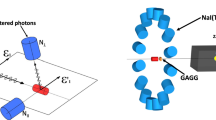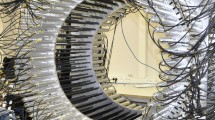Summary
The relative linear polarization of protons from two-quantum annihilation of positrons in copper was measured by Compton scattering. Measurements of the angular distribution of Compton-scattered photons arriving in coincidence were carried out over a wide range of scattering angles, both polar and azimuthal. The results agree with standard quantum-mechanical calculations assuming opposite parity of the electron and the positron. This result has implications regarding hiddenvariable theories in quantum mechanics. A theorem by Bell restricts the values that any local hidden-variable theory can predict for certain relations between measurements made on correlated systems such as the photon pair from positron annihilation. It is shown that the distributions we observed could not give results allowed by Bell's theorem if the photons were measured by ideal polarization analyzers, assuming the correctness of the usual quantum-mechanical Compton-scattering formulae. Our results are thus evidence against local hidden-variable theories.
Riassunto
Si è misurata per mezzo dello scattering di Compton la polarizzazione lineare relativa dei fotoni provenienti dall’annientamento in due quanti di positoni nel rame. Si sono eseguite misure della distribuzione angolare di fotoni che arrivano in coincidenza dopo aver subito lo scattering di Compton in corrispondenza di un esteso intervallo di angoli di scattering, sia polari che azimutali. I risultati concordano con misure standard della meccanica quantistica supponendo che elettrone e positone abbiano parità opposte. Questo risultato ha dei risvolti che riguardano le teorie delle variabili nascoste della meccanica quantistica. Un teorema di Bell restringe il campo dei valori che una teoria locale delle variabili nascoste può prevedere per certe relazioni fra misure eseguite su sistemi correlati come le coppie di fotoni provenienti dall'annientamento di positoni. Se si suppongono corrette le abituali formule della meccanica quantistica per lo scattering di Compton, si mostra che le distribuzioni che si sono osservate non possono dare risultati compatibili col teorema di Bell se si misurano i fotoni con analizzatori ideali di polarizzazione. I nostri risultati quindi forniscono argomenti contro le teorie delle variabili nascoste.
Резюме
Используя комптоновское рассеяние, измеряется относительная линейная поляризация фотонов, образованных в результате двух-фотонной аннигиляции позитронов в меди. Измерения углового расределения фотонов, испытавших комптоновские рассеяния, в схене совпадений проводятся в широком интервале углов рассеяния, полярного и азимутального. Полученные результаты согласуются с обычными квантовомеханическими вычислениями, предполагая противоположную четность электрона и позитрона. Этот результат имеет следствия для теории скрытых переменных в квантовой механике. Теорема Белла ограничивает значения, которые любая локальхая теория скрытых переменных может предсказать для некоторых соотношений между измерениями, произведенными с коррелированными системами, такими как фотонная пара, образованная при аннигиляции позитрона. Показывается, что наблюденные нами рапределения не могут дать результатов, кторые соответствовчли бы теореме Бэлла, если фотоны регистрируются с помощью идеальных поляризационных аналиааторов, предполагая правильность обычных формул квантовой механики для комптоновского рассеяния. Таким образом, наши результаты свидетедьствуют против локальных теорий скрытых переменных.
Similar content being viewed by others
References
A. Wheeler:Ann. New York Academy of Sciences,48, 219 (1946).
C. N. Yang:Phys. Rev.,77, 242 (1950).
M. H. L. Pryce andJ. C. Ward:Nature,160, 435 (1947); see alsoH. S. Snyder, S. Pasternak andJ. Hornbostel:Phys. Rev.,73, 440 (1948).
C. S. Wu andI. Shaknov:Phys. Rev.,77, 136 (1950). Earlier measurements were made by:E. Bleuler andH. L. Bradt:Phys. Rev.,73, 1398 (1948);R. C. Hanna:Nature,162, 332 (1948).
H. Langhoff:Zeits. Phys.,160, 186 (1960).
L. Kasday:Rendiconti S.I.F., Course IL (New York, N. Y., and London, 1971).
L. Kasday: Thesis, Columbia University (1972).
A Einstein, N. Rosen andB. Podolsky:Phys. Rev.,47, 777 (1935).
D. Bohm andY. Aharonov:Phys. Rev.,108, 1070 (1957);Nuovo Cimento,17, 964 (1960).
J. S. Bell:Physics,1, 195 (1964).
This arrangement had been used earlier byLanghoff (see note (5)).
J. S. Bell:Rendiconti S.I.F., Course IL (New York, N. Y., and London, 1971).
D. Bohm:Quantum Mechanics (New York, N. Y., 1951).
Actually an ideal analyzer need not exist. There could in principle exist an «almost ideal analyzer» which not be perfectly efficient but would produce outputs which would violate Bell's inequality. But no one has found such an «almost ideal analyzer» either.
M. A. Horne: Thesis, Boston University (1969).
J. F. Clauser, M. A. Horne, A. Shimony andR. A. Holt:Phys. Rev. Lett.,23, 880 (1969).
J. S. Bell: private communication. Bell's example has been outlined by one of us elsewhere: see notes (6.7)L. Kasday:Rendiconti S.I.F., Course IL (New York, N. Y., and London, 1971). Thesis, Columbia University (1972).
J. M. Jauch:Rendiconti S.I.F., Course IL (New York, N. Y., and London, 1971).
J. M. Jauch: private communication.
It has also been pointed out byJ. F. Clauser:Phys. Rev. A,6, 49 (1972), that semi-classical radiation theory gives the same prediction as the Bohm-Aharonov hypothesis.
C. A. Kocher andE. D. Commins:Phys. Rev. Lett.,18, 575 (1967).
S. J. Freedman andJ. F. Clauser:Phys. Rev. Lett,28, 938 (1972).
P. M. Pearl:Phys. Rev. D,2, 1418 (1970).
J. H. McGuire andE. S. Fry:Phys. Rev. D,7, 555 (1972).
Author information
Authors and Affiliations
Additional information
To speed up publication, the authors of this paper have agreed to not receive the profs for correction.
Work supported in part by U.S. Atomic Energy Commission and National Science Foundation
Traduzione a cura della Redazione.
Переведено редакцией.
Rights and permissions
About this article
Cite this article
Kasday, L.R., Ullman, J. & Wu, C.S. Angular correlation of compton-scattered annihilation photons and hidden variables. Nuov Cim B 25, 633–661 (1975). https://doi.org/10.1007/BF02724742
Received:
Published:
Issue Date:
DOI: https://doi.org/10.1007/BF02724742




